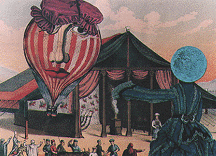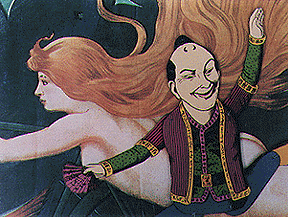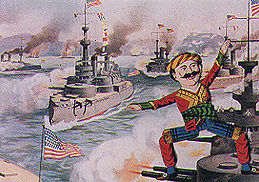by Jackie Leger
 Larry Jordan
Larry JordanFantastic landscapes of the mind is what makes the unique work of San Francisco animator Larry Jordan so compelling. With a taste for nostalgic romanticism for intricate turn-of-the-century illustrations, Jordan creates a magical universe of work using old steel engravings and collectable memorabilia. His 50-year pursuit into the subconscious mind gives him a place in the annals of cinema as a prolific animator on a voyage into the surreal psychology of the inner self.
Born in Denver, Colorado, in 1934, Jordan was introduced to filmmaking by Stan Brakhage, one of the pioneers of American experimental film. As classmates, they began to investigate the possibilities of filmed "psychodrama," a form of free-association using dream imagery. One of Jordan's earliest films, One Romantic Adventure of Edward (1952) uses erotic visual references assembled in the style of the then in-vogue classic school of "Russian montage." Brakhage made his acting debut in this film and both experimented with psycho-adventures throughout the 1950s, as did other early experimental filmmakers such as Maya Deren.
Surrealism & Collage
Jordan attended Harvard University from 1951-53, where he became attracted to the work of surrealist painter Max Ernst. He also recalls, due to his active involvement with the university's film society, being influenced by the work of another surrealist, Jean Cocteau, and in particular Blood of a Poet. But it was through his reading of Ernst's collage novels, Women Without a Head/Women with 100 Heads and A Week of Happiness, that inspired him to collect engravings, then refilming them into what became his first collage experiments. At the time, experimental filmmakers often looked to the world of art and poetry in their quest to develop a new filmic language using historical references.
 Sophie's Place
(1986)
Sophie's Place
(1986)Courtesy of Larry Jordan
In the 1950s, Jordan was spending time with Stan Brakhage on New York's Lower East Side/The Bowery, where he had the chance to meet American collagist and surrealist Joseph Cornell. Between 1955-65, Jordan studied and collaborated with Cornell, who has remained a kind of spiritual mentor for his work. Cornell, born in Nyack, New York in 1903, studied romance languages at Philips Academy before starting his own obsessive career collecting visual fragments from literature, dance, art and film publications to create masterpieces of collage, culminating in his dimensional boxes. Cornell, also interested in the work of Max Ernst and the surrealists, also made a trilogy of surrealist films: Cotillion, Midnight Party and Children's Party. Jordan has fond memories of Cornell as a cultural eccentric, passionate about poetic engagement within the context of his "monologues."
A Personal Vision
Like many other experimental filmmakers of his era, Jordan came into his own remarkable style in the 1960s. His personal vision is symbolized in Duo Concertantes (1964), heavily influenced by Ernst. This nine-minute film used engravings as backgrounds and, while having no story line per se, Jordan linked unconscious chains of events by motion. This moving collage won him many awards at festivals and paved the way for the more ambitious works to come.
While spending a summer with Cornell, Jordan made three short films using soft, lyrical animation--Dream Merchant, Pink Swine and Gymnopede--all using well-known sound tracks. In 1969, he created what is considered one of his best films, Our Lady of the Sphere. The film takes its theme from the Tibetan Book of the Dead and relies on pure intuitive filmmaking in its structure, a technique that works best for Jordan's fine-tuned talents.
During the 1970s, Jordan exhibited internationally in galleries and specialized cinemas. It was a prolific time, in which he made several films of note.
Rime of the Ancient Mariner, based on the Coldridge poem, had Orson Welles as the narrator. Illustrations by Gustav Doré form the visual compositions of the intricate trains of free thought woven into moods and feelings brought about through free association.

The Visible Compendium
Courtesy of Larry Jordan
Magical and Enigmatic
By the 1980s, Jordan, a master at his craft, single-handedly made Sophie's
Place, an 84 minute feature, between 1983-87. The 129,600 single-framed
images revolve around the mosque of Saint Sofia in "Constantinople."
Again, the complex world of fine art engravings are interlaced with mysterious
trees and castles, while objects change objects through rapid montage, leaving
the viewer immersed in a visual web of experience. Like a stream of consciousness
meditation, this epic reflects on Sophia, godess of wisdom and includes
cutouts ranging from Victorian prints to Daliesque dreams. This awesome
technique lets the film unfold in a magical and enigmatic way.
At this time, Jordan began to focus on colored engravings. His short interim
piece, Masquerade evokes a tragic, romantic mood, while Moonlight
Sonata calls forth a lyrical feeling. With every film, Jordan tries
to transform objects in space like humans might transform themselves in
life. Each cinematic journey uses a set of symbols to elicit thoughts and
emotions of transformation. Jordan believes that all his films come from
the collective unconscious, not just in terms of archetypes or specific
symbols, but in terms of mirror like fragments of ritual, cult and religious
practices throughout human history.
In 1990, Jordan made another classic Visible Compendium, a 17-minute
work which took 2-1/2 years to make and relates to an idyllic trip in a
hot air balloon as an enigmatic journey. Here, he also begins to focus on
sound as collage by collecting audio bits and pieces as he did with pictures.
The film itself is cut to the soundtrack, which mixed both recognizable
and unrecognizable sounds, making it a true "compendium." The
film is a kind of a puzzle constructed from fragments of unnamed meanings
and fragments of light--light being the base for all film--in which Jordan
wants the viewer to discover his own meaning in these films by bringing
a personal predisposition into play. Today, Visible Compendium remains
an important experiment into the secrets of the unknown.
 The Visible
Compendium
The Visible
Compendium
Courtesy of Larry Jordan
For his next film, Jordan decided to use animation and (mostly) live-action
techniques in the form of a biodocumentary mixed with segments of the work
of the imagist poet HD (Hilda Doolittle), in particular, her poem "Hermetic
Definitions." The HD Trilogy includes short filmed pieces of
contemporary poet Joanna McClure as she journeys through ancient ruins and
a Mediterranean village, seeking to captivate Doolittle's essence. Born
in Pennsylvania, HD spent much of her adult life among the literary circles
of England and Europe. She died in 1961 at age 77 and "Hermetic Definitions"
was her last poem. The idea behind Jordan's film was to encourage viewers
to discover the importance of the poet and her work.
Today, Larry Jordan teaches at the San Francisco Art Institute and continues
his lifelong search into the possibilities for collage animation. He is
collecting more engravings and visual fragments for two projects Glass
House and Kabbalah. He forsees these films taking 10 years to
complete, but patience is a virtue in the work of Larry Jordan. Both films
intend to bring a mystical wheel of images into view, as his interests remain
in the deep realm of spirtiual mysticism, from ancient Egypt through the
medieval Kabbalah to the present. He seems to have a monumental task ahead
of him.
When not engaged in the painstaking frame-by-frame process of animation,
Jordan works as a kinetic sculptor making three dimensional boxes from the
same materials as his films. One might consider his art work as films in
reverse. One thing is certain, Jordan has brought the fine art of collage
technique to a pinnacle throught his career.
Jackie Leger is a Santa Monica-based documentary filmmaker interested
in the roots of American experimental film.
Larry Jordan Filmography
Please note, all films were done in 16mm color and sound, except
where noted. Films with an asterick (*) next to the title are animated.

The Visible Compendium
Courtesy of Larry Jordan
1953
Morningame, silent, black & white, 6 minutes.
1954
The Child's Hand, b&w, 7 min.
Man is in Pain, b&w, 4 min.
1956
Trumpit, b&w, 6 min.
3, b&w, 6 min.
Undertow, 7 min.
1957
Waterlight, 7 min.
1958
Triptych in Four Parts, 12 min.
1959
The Soccer Game, b&w, 5 min.
Minerva Looks Out Into the Zodiac,b&w, 6 min.
1960
Hymn in Praise of the Sun, 8 min.
Portrait of Sharon, 7 min.
The Herb Moon, silent, 3 min.
The Season's Changes: To Contemplate, silent, b&w, 7 min.
1962
The 40 and 1 Nights, or Jess's Didactic Nickelodeon, 6 min.
Circus Savage, silent, color and b&w, 150 min.
*Enid's Idyll, b&w (green tint), 11 min.
1963
Shomio,3 min.
*Pink Swine, b&w, 3 min.
1964
The One Romantic Venture, b&w, 8 min. Production began in
1952.
*Duo Concertantes, b&w, 9 min. Production began in 1961.
*The Dream Merchant, b&w, 3 min.
Rodia-Estudiantia, 4 min.
Big Sur: The Ladies, 3 min.
Johnnie,3 min.
Jewel Face, 6 min.
1965
*Hamfat Asar,b&w, 15 min.
1966
The Old House, Passing, b&w, 45 min.
*Gymnopedies, b&w (blue tint), 6 min.
1969
Hildur and the Magician,b&w, 70 min. Production began in
1967.
*Our Lady of the Sphere,10 min.
1970
Living is Dying, b&w, 9 min.
1972
Sacred Art of Tibet,28 min. Production began in 1970.
1973
Plainsong, 7 min.
Fireweed, 3 min.
*Orb, 5 min.
1974
*Once Upon a Time, 12 min.
1976
The Apparition, 50 min. Production began in 1974.
1977
*The Rime of the Ancient Mariner, 42 min. Narrated by Orson Welles.
1978
*Ancestors, b&w, 5 min.
1979
Visions of a City, b&w (sepia tint), 9 min. Production began
in 1957.
Cornell, 1965, 8 min. Production began in 1965.
*Moonlight Sonata, 5 min.
1980
*Finds of the Fortenight, silent, b&w, 9 min.
1981
*Masquerade, 5 min.
1983
Magenta Geryon, 35 min., which began production in 1981, includes:
· Adagio, 8 min.
· In a Summer Garden, 15 min.
· Winter Light, 9 min.

Sophie's Place (1986)
Courtesy of Larry Jordan
1986
*Sophie's Place, 84 min. Production began in 1983.
1988
Tapestry, 18 min.
1990
*The Visible Compendium, 17 min.
1992
The Black Oud, b&w (sepia tint), 45 min.
1993
The Grove, b&w (orange tint), 45 min.
1994
Star of the Day, b&w (orange tint), 25 min.